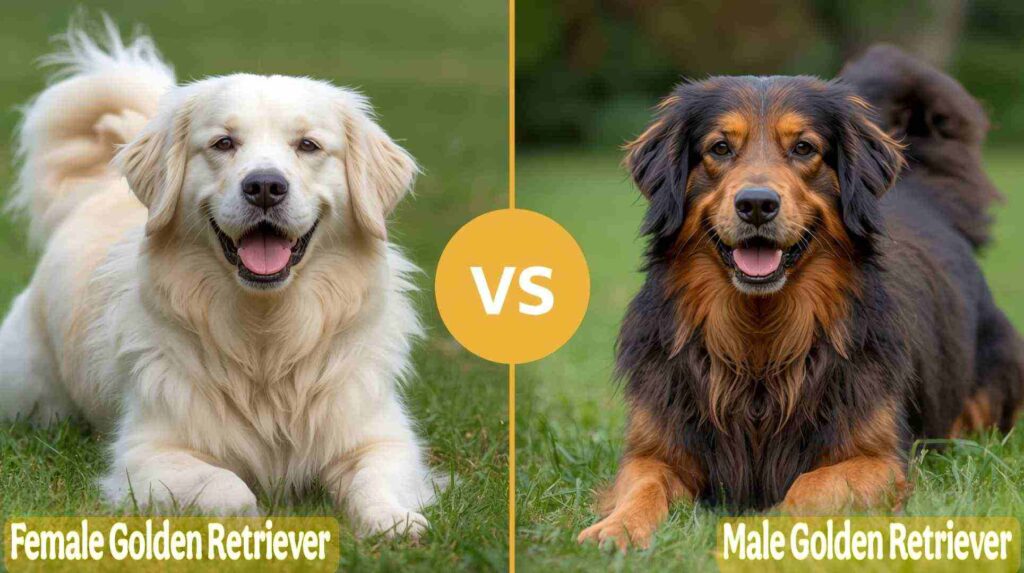Male Golden Retriever vs Female: Complete Comparison Guide

When choosing between a male golden retriever vs female, potential dog owners often wonder about the significant differences that could influence their decision. This comprehensive guide examines the key distinctions between male and female Golden Retrievers, backed by statistics and expert insights to help you make an informed choice.
Table of Contents
Physical Differences: Size and Appearance Statistics
Size Variations Between Male Golden Retriever vs Female
The most notable difference between male golden retriever vs female lies in their physical dimensions. According to the American Kennel Club (AKC), males weigh 65–75 pounds and females weigh 55–65 pounds. Males are also taller than females by as much as 2.5 inches.
Key Size Statistics:
- Male Golden Retrievers: 23-24 inches tall, 65-75 pounds
- Female Golden Retrievers: 21-22 inches tall, 55-65 pounds
- Weight Difference: Males typically weigh 10-20 pounds more than females
- Height Difference: Males stand 2-4 inches taller on average
Facial Structure and Build
Beyond size, Male Golden Retrievers also tend to have broader heads and snouts, while females have a more narrow head and a skinnier snout. In general, females are more slender, while males tend to have a stockier appearance. These physical differences become more apparent when comparing male golden retriever vs female side by side.
As one Golden Retriever breeder notes: “The difference in build between males and females is quite distinct once you know what to look for – males have that robust, sturdy appearance while females maintain a more elegant, refined look.”
Temperament and Behavioral Differences
Personality Traits: Male Golden Retriever vs Female
While both genders share the Golden Retriever’s characteristic friendly nature, subtle differences exist in temperament between male golden retriever vs female. Adult females are often perceived as calmer compared to the males, which may be due to early maturation. However, individual personality plays a significant role, and breed characteristics generally overshadow minor differences due to gender.
Behavioral Patterns
Male Golden Retriever Characteristics:
- More playful and energetic throughout life
- Tend to be more attention-seeking
- Often more affectionate and clingy
- Male Golden Retrievers mark more than female Golden Retrievers
Female Golden Retriever Characteristics:
- Generally mature faster mentally
- Often more independent and reserved
- Female Goldens are sometimes believed to be more careful and observant around small children, whereas male Goldens might be more carefree and playful
- Typically easier to house train
Health Considerations and Lifespan
Gender-Related Health Statistics
When comparing male golden retriever vs female health profiles, both genders are susceptible to similar breed-specific conditions. However, some health considerations may vary:
Common Health Issues Affecting Both Genders:
- Hip and elbow dysplasia
- Heart conditions
- Eye disorders
- Cancer (particularly hemangiosarcoma and lymphoma)
Gender-Specific Considerations:
- Females face risks related to reproductive health if not spayed
- Males may have slightly higher rates of certain cancers
- Spaying/neutering timing can affect growth and development differently
A veterinary expert explains: “While Golden Retrievers as a breed face certain health challenges, the differences between male and female health outcomes are minimal when proper preventive care is provided.”
Training and Intelligence Differences
Learning Patterns in Male Golden Retriever vs Female
Both male and female Golden Retrievers are highly intelligent and trainable, ranking among the top dog breeds for obedience. However, training approaches may need slight adjustments:
Male Training Characteristics:
- May take longer to mentally mature (18-24 months)
- Often more food-motivated
- Can be easily distracted but highly eager to please
- Respond well to positive reinforcement
Female Training Characteristics:
- Tend to mature faster (12-18 months)
- Often more focused during training sessions
- May be slightly more independent in decision-making
- Generally easier to housetrain
Exercise and Activity Requirements
Energy Levels: Male Golden Retriever vs Female
Golden Retrievers are active dogs regardless of gender, but energy levels can vary between male golden retriever vs female:
- Daily Exercise Needs: Both genders require 60-90 minutes of exercise
- Activity Preferences: Males often prefer more vigorous play, while females may enjoy varied activities
- Mental Stimulation: Both genders need mental challenges to prevent boredom
Grooming and Maintenance
Coat Care Requirements
The grooming needs between male golden retriever vs female are essentially identical:
- Brushing: Daily brushing recommended for both genders
- Shedding: Heavy seasonal shedding occurs twice yearly
- Professional Grooming: Every 6-8 weeks for optimal coat health
- Bathing: As needed, typically monthly or when dirty
Cost Considerations
Financial Factors in Male Golden Retriever vs Female
Initial Costs:
- Purchase price typically similar regardless of gender
- Spaying generally costs more than neutering ($200-800 vs $150-500)
Ongoing Expenses:
- Food costs may be higher for males due to larger size
- Healthcare costs generally similar between genders
- Insurance premiums may vary slightly based on size
As noted by a Golden Retriever expert: “The long-term financial commitment is substantial for both genders, with males requiring slightly more food due to their larger size, but the difference is minimal in the overall cost of ownership.”
Making Your Decision: Male Golden Retriever vs Female
Factors to Consider
When choosing between male golden retriever vs female, consider:
- Living Space: Larger males need more room
- Activity Level: Match your energy to your dog’s needs
- Other Pets: Consider existing pet dynamics
- Personal Preference: Individual personality matters most
- Time Commitment: Both genders need significant attention
Ideal Homes for Each Gender
Male Golden Retrievers thrive in homes with:
- Active families who enjoy outdoor activities
- Owners who appreciate affectionate, attention-seeking personalities
- Households with adequate space for larger dogs
Female Golden Retrievers are perfect for:
- Families seeking a slightly calmer companion
- First-time dog owners who prefer easier training
- Homes where a more independent personality is preferred
For internal linking opportunities, consider exploring our comprehensive Golden Retriever guides for additional breed information.
For authoritative breed standards and additional information, visit the AKC official Golden Retriever breed page.
Conclusion
The decision between male golden retriever vs female ultimately depends on your personal preferences, lifestyle, and family situation. While males tend to be larger, more playful, and attention-seeking, females often mature faster and display more independent personalities. Both genders make exceptional family companions with proper training, socialization, and care.
The physical differences in size and temperament variations are relatively minor compared to the individual personality of each dog. Whether you choose a male or female, you’ll gain a loyal, intelligent, and loving companion that exemplifies everything wonderful about the Golden Retriever breed.
Statistics show that both male golden retriever vs female make equally devoted family pets, with owner satisfaction rates remaining consistently high across both genders. The most important factor isn’t gender, but rather finding a healthy puppy from a reputable breeder who conducts proper health testing.
As you weigh these considerations, remember that the bond you form with your Golden Retriever will be unique regardless of gender – but have you considered which personality traits align best with your family’s lifestyle and expectations?






